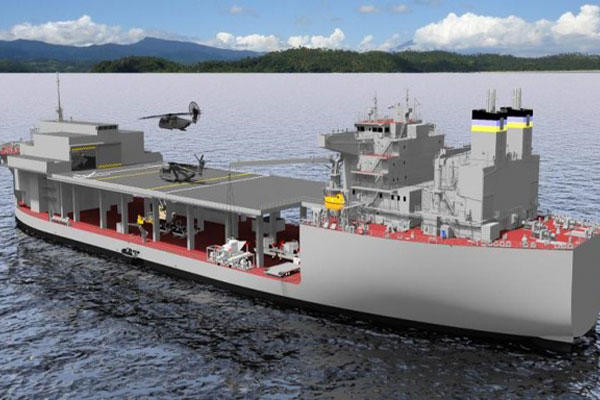Navy and Marine Corps leaders see mobile, off-shore bases as the key to the U.S. military's ability to respond to short-fuse contingency operations around the world.
As America shifts its focus on the Pacific, the sea services want the ability to launch amphibious operations from adaptable, floating platforms that sit 100 miles off shore.
"To do the kind of things around the world we need to do in-and-out we've got to innovate," Chief of Naval Operations Admiral Jonathan Greenert told an audience Monday at the opening of the Navy League 2014 Sea, Air and Space Exposition.
The Navy is building Mobile Landing Platform ships designed to become the centerpiece of the Sea Base concept. These large platforms can be used for Landing Craft Air Cushion, or LCAC, hovercraft operations, or to support fleet hospitals.
The Navy also plans to adapt three MPLs into what's known as Afloat Forward Staging Bases – floating flight decks for large helicopters and MV-22 Ospreys, Greenert said, adding the first AFSB is about 50 percent complete.
"We are going to deploy those around the world they are not going out sitting on a hook," he said. "This is real. ... It's the new normal out there, and these are the kind of ships we need."
The new concept is an attempt to cope with the growing demand for naval forces at a time when defense spending is shrinking under sequestration cuts.
With additional cuts coming in 2016, 20 retired Marine generals recently submitted a joint letter to Congress urging them to fund a minimum of 38 amphibious warships to meet the Marine Corps ongoing expeditionary mission.
The Navy can only afford to buy 33 of these amphibious ships even though it has a requirement of 38, Greenert said.
"Frankly, we need about 50 amphibious gray hulls to get done what we need to around the world today," Greenert said.
The Marine Corps also stressed a need for more Navy ships and expressed support for sea-base vessels such as the AFSB.
"These are things that are new to us and yet they are going to add a tremendous capability," Amos said. "They are going to be protected by surface action groups by carrier strike groups, battle groups -- there is literally going to be hundreds of ships protecting this sea base but from this sea base will be U.S. Naval forces that will come ashore."
"They will come ashore in LCAC. They will fly ashore in MV-22 Ospreys," Amos said. "They will get their gear slung underneath heavy-lift helicopters and there are going to be Marines riding in their amphibious combat vehicles. ... But they will come from the sea base, and we need to embrace this."
-- Matthew Cox can be reached at matthew.cox@monster.com



























